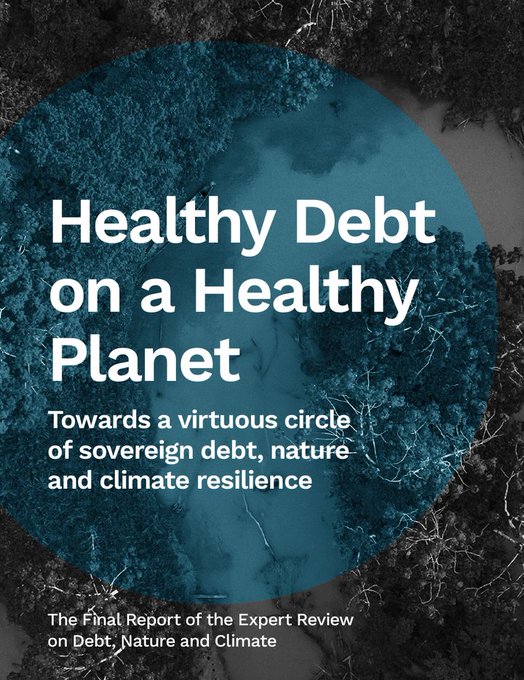Experts call for debt restructuring and new financial instruments to tackle climate change and nature loss in ‘critical decade of action’
Work area(s)
- The threat of global recession and cuts to overseas aid make it more vital than ever to tackle ‘triple crisis’ of indebtedness, climate impacts and nature loss, says landmark report.
- IMF and World Bank urged to reform their debt sustainability analysis and help developing countries restructure their debts to support climate-resilient and nature- smart growth plans within ‘critical decade of action’.
- Developed countries, development banks and private sector urged to develop innovative new financing instruments for green investments in light of recent global upheaval.

A new expert report commissioned by the governments of Colombia, Kenya, France and Germany urges the international community to tackle the ‘vicious circle’ of rising debt burdens, climate change and nature loss.
The Expert Review on Debt, Nature and Climate shows how climate change and nature risks are worsening the growth and debt prospects of many emerging market and developing countries (EMDCs) at the same time as rising debt service burdens are reducing their ability to tackle such risks. The report aims to support countries make their debt more sustainable to finance much-needed climate and nature-positive growth during what the experts dub a ‘critical decade of action’.
Noting that many EMDCs are now facing net capital outflows due to interest repayments exceeding new lending (totaling around $4billion in 2023 for low and lower middle-income countries) and that business leaders surveyed by the World Economic Forum now see environmental risks as the top barriers to global growth, the report calls on:
- The IMF and World Bank to revise their Debt Sustainability Analysis models to better incorporate nature and climate risks and the economic benefits of reducing them, and the credit ratings agencies to follow suit.
- Developed and other creditor countries and the IMF to provide new programmes enabling EMDCs in different circumstances to restructure or refinance their debts to support climate-resilient and nature-smart development and growth plans.
- Multilateral development banks, borrowers and creditors to expand the range of climate-and nature-related financial instruments, such as climate resilient debt clauses, debt-for-nature and debt-for-climate swaps, and sustainability-linked financing.
- Donor countries, the private sector and MDBs to develop innovative new financial instruments, including the securitisation of future aid flows, to provide new sources of finance at scale for climate and nature investment in EMDCs.
- International financial institutions and the UN regional economic commissions to establish a ‘one-stop shop’ for technical advice to EMDCs on sustainable debt management.
Vera Songwe, Co-Chair of the Expert Review said: “With climate impacts growing more severe, countries can now improve their growth prospects and debt sustainability by investing in climate and nature resilience. But to do this many need to restructure their debts. Our report offers practical proposals to the IMF and to borrower and creditor countries on how to do this. We urge their adoption.”
Moritz Kraemer, Co-Chair of the Expert Review said: “The new geopolitical context, with international aid in decline, makes it more important than ever that the international community develops new ways of raising finance from the private sector for climate and nature investments at scale. Countries should be able to pursue the climate-resilient, low-carbon and nature-positive economic growth they need; our report shows how this can be done.”
What is the Expert Review on Debt, Nature and Climate?
The Review was established by the governments of Colombia, Kenya, France and Germany to assess the relationships between sovereign debt and climate and nature impacts and policy.
It is being conducted by an Independent Expert Group (IEG) co-chaired by Vera Songwe, Chair and Founder of the Liquidity and Sustainability Facility and former UN Under-Secretary General, and Moritz Kraemer, Chief Economist at LBBW Bank and former Global Chief Ratings Officer of S&P Global (previously known as Standard and Poor’s). Coming from both developed and developing countries, members of the IEG have expertise and experience drawn from borrower and creditor country governments, international financial institutions, the private sector, academia and civil society.
The Review is being supported by a Secretariat drawn from four independent research institutes: the UN Economic Commission for Latin America (based in Santiago, Chile), ODI Global (based in London, UK), the Finance for Development Lab of the Paris School of Economics (based in Paris, France) and the Africa Centre for Economic Transformation (based in Accra Ghana).
What is the ‘vicious circle’?
How the climate and nature crises can affect the debt crisis:
- Increased borrowing to fund disaster response and recovery.
- Increased borrowing to meet the higher upfront costs associated with climate- and nature-positive development
- Shocks and stresses constrain economic growth and public revenues, and therefore reduce capacities to service debt
- Higher borrowing costs due to increased climate- and nature-related risks, higher debt burdens and slower growth rates
How the debt crisis affects the climate and nature crises:
- Higher debt servicing reduces fiscal space for investment in nature and climate action.
- Higher debt servicing increases the credit risk profile of countries, which in turn makes it more expensive to borrow for investment in nature and climate action.
- Higher financing costs reduce the viability of capital-intensive climate- and nature-smart measures.
- Higher debt servicing creates incentives and requirements for increased resource extraction.